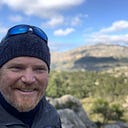City as Process
Breakdown & breakthrough in Socio-Ecological-Systems
To understand cities as processes embedded in bio-physical patterns of change and transformation requires new frameworks for thinking. As complex dynamic systems cities behave like ecosystems and patterns of periodic (localized) collapse and disturbance are critical aspects of any city’s innovation, transformation and evolution.
The three aspects of resilience — persistence, adaptive capacity and transformability — describe important capacities of living systems:
i) to resist collapse and maintain vital functions,
ii) to adapt to changing conditions (learn and self-organise) and
iii) in the case of Socio-Ecological Systems to apply foresight and anticipation to transform the system towards increased health and an improved capacity to respond wisely and creatively to disruptions and change.
This dynamic understanding of resilience as the capacity to persist, adapt and transform is akin to Antonovsky’s Salutogenic approach to health. Rather than waiting for symptoms or (problems) to occur and then treat or solve those for the affected, the Salutogenic way of working builds individual and collective capacity to realise the potential for positive health. Antonovsky’s work also identified the importance of social cohesion, shared frameworks of meaning and mutual support as key factors for positive health.
The adaptive cycle is a model of natural patterns of change in ecosystems and eco-social systems. It consists of four distinct phases: ‘growth or exploitation’ (r); ‘conservation’ (K) of established patterns and resource distribution; ‘collapse or release’ (Ω); and reorganisation (α). The adaptive cycle is often drawn as a Möbius loop that joins these four phases.
Gunderson and Holling explain that the word ‘panarchy’ describes nature’s (w)holistic hierarchies and the complex dynamics that link different spatial scales and their fast- and slow-moving processes into an interconnected whole. The panarchy interlinks adaptive cycles occurring at multiple temporal and spatial scales simultaneously. It elucidates the interplay between change and persistence in scale-linked socio-ecological systems.
The model can help us visualise the scale-linking complexity of natural processes. Facing this fractal complexity of interacting transformative processes — nested adaptive cycles spanning across temporal and spatial scales — invites us to stay mindful of the limits of prediction and control that we face as participants in such complexity.
The figure below is a visual representation of panarchy. Fast-moving cycles at smaller scales are more likely to innovate and test innovations. While slow-moving cycles at larger scales “stabilise and conserve accumulated memory of past successful, surviving experiments. The whole panarchy is both creative and conserving. The interactions between cycles combine learning with continuity” (Resilience Alliance, 2015c).
An understanding of cities as Salutogenic processes must embrace that “death is Nature’s ingenious device to create plenty of life” (Goethe, 1829). Periodic disruption, and the dissolution and breakdown of ossified structures that no longer serve are important aspects of dynamic change in natural systems — cities included!
Salutogenic cities as part of bioregional Socio-Ecological-Systems in transformation need to persist, adapt and transform in response to changing circumstances. Often it is the breakdown of rigid old structures, outdated patterns and processes that no longer serve that actually enable the breakthrough to new patterns of health and regeneration”
Note: this was the final sub-chapter of a longer book chapter I wrote for the edition of Urban Hub 20 (see page 37–45):
—
If you like the post, please clap AND remember that you can clap up to 50 times if you like it a lot ;-)!
Daniel Christian Wahl — Catalyzing transformative innovation in the face of converging crises, advising on regenerative whole systems design, regenerative leadership, and education for regenerative development and bioregional regeneration.
Author of the internationally acclaimed book Designing Regenerative Cultures
Please consider supporting my ongoing work by becoming a patron:
